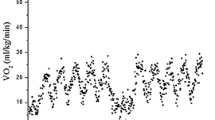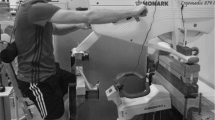Abstract
Purpose
To compare heart rate (HR), oxygen consumption (VO2), blood lactate (BL), and ratings of perceived exertion (RPE) during arm cycling with and without a blood flow restriction (BFR).
Methods
Twelve healthy males (age: 23.9 ± 3.75 years) completed four, randomized, 15-min arm cycling conditions: high-workload (HW: 60% maximal power output), low-workload (LW: 30% maximal power output), low-workload with BFR (LW-BFR), and BFR with no exercise (BFR-only). In the BFR conditions, cuff pressure to the proximal biceps brachii was set to 70% of occlusion pressure. HR, VO2, and RPE were recorded throughout the exercise, and BL was measured before, immediately after, and five minutes post-exercise. Within-subject repeated-measures ANOVA was used to evaluate condition-by-time interactions.
Results
HW elicited the greatest responses in HR (91% of peak; 163.3 ± 15.8 bpm), VO2 (71% of peak; 24.0 ± 3.7 ml kg−1 min−1), BL (7.7 ± 2.5 mmol L−1), and RPE (14 ± 1.7) and was significantly different from the other conditions (p < 0.01). The LW and LW-BFR conditions did not differ from each other in HR, VO2, BL, and RPE mean of conditions: ~ 68%, 41%, 3.5 ± 1.6 mmol L−1, 10.4 ± 1.6, respectively; p > 0.05). During the BFR-only condition, HR increased from baseline by ~ 15% (on average) (p < 0.01) without any changes in VO2, BL, and RPE (p > 0.05).
Conclusions
HW arm cycling elicited the largest and most persistent physiological responses compared to LW arm cycling with and without a BFR. As such, practitioners who prescribe arm cycling for their clients should be advised to augment the demands of exercise via increases in exercise intensity (i.e., power output), rather than by adding BFR.




Similar content being viewed by others
Data availability
The datasets generated during and/or analyzed during the current study are available from the corresponding author upon reasonable request.
Abbreviations
- BFR:
-
Blood flow restriction
- HR:
-
Heart rate
- VO2 :
-
Oxygen consumption
- BL:
-
Blood lactate
- RPE:
-
Ratings of perceived exertion
- RPM:
-
Revolutions per minute
- W:
-
Watts
- AOP:
-
Arterial occlusion pressure
- BMI:
-
Body mass index
- HW:
-
High-workload
- LW:
-
Low-workload
- LW-BFR:
-
Low-workload with BFR
- BFR-only:
-
BFR with no exercise
- ANOVA:
-
Analysis of variance
References
Abe T, Kearns CF, Sato Y (2006) Muscle size and strength are increased following walk training with restricted venous blood flow from the leg muscle, Kaatsu-walk training. J Appl Physiol (bethesda, Md.: 1985) 100(5):1460–1466. https://doi.org/10.1152/japplphysiol.01267.2005
Abe T, Fujita S, Nakajima T, Sakamaki M, Ozaki H, Ogasawara R, Sugaya M, Kudo M, Kurano M, Yasuda T, Sato Y, Ohshima H, Mukai C, Ishii N (2010) Effects of low-intensity cycle training with restricted leg blood flow on thigh muscle volume and VO2MAX in young men. J Sports Sci Med 9(3):452–458
American College of Sports Medicine (2018) ACSM’s guidelines for exercise testing and prescription (Tenth). Wolters, Kluwer
Borg GA (1982) Psychophysical bases of perceived exertion. Med Sci Sports Exerc 14(5):377–381
Calbet JAL, Holmberg H-C, Rosdahl H, van Hall G, Jensen-Urstad M, Saltin B (2005) Why do arms extract less oxygen than legs during exercise? Am J Physiol Regul Integr Comp Physiol 289(5):R1448-1458. https://doi.org/10.1152/ajpregu.00824.2004
Clarkson MJ, Conway L, Warmington SA (2017) Blood flow restriction walking and physical function in older adults: a randomized control trial. J Sci Med Sport 20(12):1041–1046. https://doi.org/10.1016/j.jsams.2017.04.012
Clarkson MJ, May AK, Warmington SA (2019) Chronic blood flow restriction exercise improves objective physical function: a systematic review. Front Physiol 10:1058. https://doi.org/10.3389/fphys.2019.01058
de Oliveira MFM, Caputo F, Corvino RB, Denadai BS (2016) Short-term low-intensity blood flow restricted interval training improves both aerobic fitness and muscle strength. Scand J Med Sci Sports 26(9):1017–1025. https://doi.org/10.1111/sms.12540
Farkas GJ, Gorgey AS, Dolbow DR, Berg AS, Gater DR (2021) Energy expenditure, cardiorespiratory fitness, and body composition following arm cycling or functional electrical stimulation exercises in spinal cord injury: a 16-week randomized controlled trial. Top Spinal Cord Injury Rehabil 27(1):121–134. https://doi.org/10.46292/sci20-00065
Formiga MF, Fay R, Hutchinson S, Locandro N, Ceballos A, Lesh A, Buscheck J, Meanor J, Owens JG, Cahalin LP (2020) Effect of aerobic exercise training with and without blood flow restriction on aerobic capacity in healthy young adults: a systematic review with meta-analysis. Int J Sports Phys Ther 15(2):175–187
Garber CE, Blissmer B, Deschenes MR, Franklin BA, Lamonte MJ, Lee IM, Nieman DC, Swain DP, American College of Sports Medicine (2011) American College of Sports Medicine position stand. Quantity and quality of exercise for developing and maintaining cardiorespiratory, musculoskeletal, and neuromotor fitness in apparently healthy adults: Guidance for prescribing exercise. Med Sci Sports Exerc 43(7):1334–1359. https://doi.org/10.1249/MSS.0b013e318213fefb
Loenneke JP, Thrower AD, Balapur A, Barnes JT, Pujol TJ (2012) Blood flow-restricted walking does not result in an accumulation of metabolites. Clin Physiol Funct Imaging 32(1):80–82. https://doi.org/10.1111/j.1475-097X.2011.01059.x
Loenneke JP, Allen KM, Mouser JG, Thiebaud RS, Kim D, Abe T, Bemben MG (2015) Blood flow restriction in the upper and lower limbs is predicted by limb circumference and systolic blood pressure. Eur J Appl Physiol 115(2):397–405. https://doi.org/10.1007/s00421-014-3030-7
Mendonca GV, Vaz JR, Teixeira MS, Grácio T, Pezarat-Correia P (2014) Metabolic cost of locomotion during treadmill walking with blood flow restriction. Clin Physiol Funct Imaging 34(4):308–316. https://doi.org/10.1111/cpf.12098
Naves JPA, Rebelo ACS, Silva LRBE, Silva MS, Ramirez-Campillo R, Ramírez-Vélez R, Gentil P (2019) Cardiorespiratory and perceptual responses of two interval training and a continuous training protocol in healthy young men. Eur J Sport Sci 19(5):653–660. https://doi.org/10.1080/17461391.2018.1548650
Ørtenblad N, Nielsen J, Boushel R, Söderlund K, Saltin B, Holmberg H-C (2018) The muscle fiber profiles, mitochondrial content, and enzyme activities of the exceptionally well-trained arm and leg muscles of elite cross-country skiers. Front Physiol 9:1031. https://doi.org/10.3389/fphys.2018.01031
Ozaki H, Brechue WF, Sakamaki M, Yasuda T, Nishikawa M, Aoki N, Ogita F, Abe T (2010) Metabolic and cardiovascular responses to upright cycle exercise with leg blood flow reduction. J Sports Sci Med 9(2):224–230
Ozaki H, Miyachi M, Nakajima T, Abe T (2011) Effects of 10 weeks walk training with leg blood flow reduction on carotid arterial compliance and muscle size in the elderly adults. Angiology 62(1):81–86. https://doi.org/10.1177/0003319710375942
Park S, Kim JK, Choi HM, Kim HG, Beekley MD, Nho H (2010) Increase in maximal oxygen uptake following 2-week walk training with blood flow occlusion in athletes. Eur J Appl Physiol 109(4):591–600. https://doi.org/10.1007/s00421-010-1377-y
Renzi CP, Tanaka H, Sugawara J (2010) Effects of leg blood flow restriction during walking on cardiovascular function. Med Sci Sports Exerc 42(4):726–732. https://doi.org/10.1249/MSS.0b013e3181bdb454
Scherr J, Wolfarth B, Christle JW, Pressler A, Wagenpfeil S, Halle M (2013) Associations between Borg’s rating of perceived exertion and physiological measures of exercise intensity. Eur J Appl Physiol 113(1):147–155. https://doi.org/10.1007/s00421-012-2421-x
Smith PM, Doherty M, Drake D, Price MJ (2004) The influence of step and ramp type protocols on the attainment of peak physiological responses during arm crank ergometry. Int J Sports Med 25(8):616–621. https://doi.org/10.1055/s-2004-817880
Thomas HJ, Scott BR, Peiffer JJ (2018) Acute physiological responses to low-intensity blood flow restriction cycling. J Sci Med Sport 21(9):969–974. https://doi.org/10.1016/j.jsams.2018.01.013
Willis SJ, Borrani F, Millet GP (2019a) Leg- vs arm-cycling repeated sprints with blood flow restriction and systemic hypoxia. Eur J Appl Physiol 119(8):1819–1828. https://doi.org/10.1007/s00421-019-04171-0
Willis SJ, Peyrard A, Rupp T, Borrani F, Millet GP (2019b) Vascular and oxygenation responses of local ischemia and systemic hypoxia during arm cycling repeated sprints. J Sci Med Sport 22(10):1151–1156. https://doi.org/10.1016/j.jsams.2019.05.001
Willis SJ, Millet GP, Borrani F (2020) Insights for blood flow restriction and hypoxia in leg versusarm submaximal exercise. Int J Sports Physiol Perform 15:714–719. https://doi.org/10.1123/ijspp.2019-0168
Funding
This study was funded by the International Research Opportunities Program (IROP) at the University of New Hampshire. AMV is supported by an Australian Research Council Discovery Early Career Researcher Award (DE190100694).
Author information
Authors and Affiliations
Contributions
BRS, AMV, and SBC conceived and designed the research. MLF, BRS, AMV, and SBC obtained funding. MLF and AMV conducted experiments. MLF and SBC analyzed data. MLF, BRS, AMV, and SBC wrote the manuscript. All authors read and approved the manuscript.
Corresponding author
Ethics declarations
Conflict of interest
The authors have no relevant financial or non-financial interests to disclose.
Ethics approval
Approval was obtained from the University of New Hampshire’s Institutional Review Board and Murdoch University’s Human Research Ethics Committee. The procedures used in this study adhere to the tenets of the Declaration of Helsinki.
Consent to participate and publish
Written informed consent was obtained from all individual participants regarding participation in the study and publication of their data.
Additional information
Communicated by Philip D. Chilibeck.
Publisher's Note
Springer Nature remains neutral with regard to jurisdictional claims in published maps and institutional affiliations.
Rights and permissions
Springer Nature or its licensor (e.g. a society or other partner) holds exclusive rights to this article under a publishing agreement with the author(s) or other rightsholder(s); author self-archiving of the accepted manuscript version of this article is solely governed by the terms of such publishing agreement and applicable law.
About this article
Cite this article
Frechette, M.L., Scott, B.R., Vallence, AM. et al. Acute physiological responses to steady-state arm cycling ergometry with and without blood flow restriction. Eur J Appl Physiol 123, 901–909 (2023). https://doi.org/10.1007/s00421-022-05118-8
Received:
Accepted:
Published:
Issue Date:
DOI: https://doi.org/10.1007/s00421-022-05118-8




